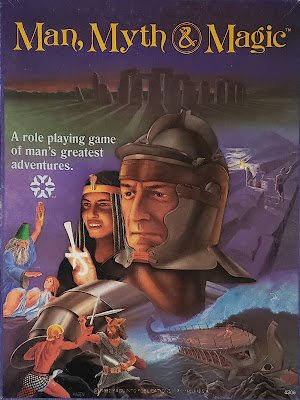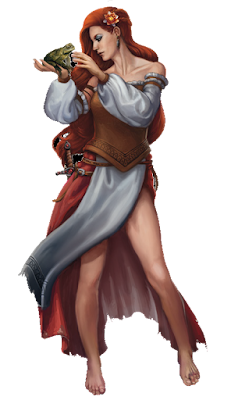It really isn't the Forgotten Realms' answer to Gondolin, but I am at a loss to come up with a better example.
Back in the early 90s, TSR was hitting its stride with big boxed sets for the Realms. The Ruins of Myth Drannor (1993) is a prime example, a sprawling campaign supplement that promised to take players deep into one of the most iconic fallen cities of D&D lore. Like a lot of the Realms material of this era, it’s packed to the brim, sometimes messy, always ambitious.
MY first encounter with this mythical Elven realm didn't come from this boxed set, but rather the Forgotten Realms novel Spellfire. I have been looking forward to checking it out on its own for some time, but the prices for it on eBay are all over the place. So, I am settling for the PDF and print-on-demand copies.
The Ruins of Myth Drannor (2e)
1993. By Ed Greenwood. Artists: Erik Olson, Jeff Easley, Arnie Sweikel, and John Sattem
While I will refer to the "boxed set" here, since that is how it was originally published, I am working off of my Print on Demand version from DriveThruRPG.
The box itself comes with three books, a pile of maps, and the Monstrous Compendium monsters. The full “big box” treatment I have come to expect from 1990s Realms.
The Ruins of Myth Drannor Campaign Guide
128 Pages.
This book details the extensive history of Myth Drannor, from its zenith as the "City of Song" to its tragic downfall. It provides in-depth information on the various factions and creatures that now inhabit the ruins, offering a rich and dangerous environment for exploration. The materials include maps of the city and surrounding areas, new rules for the unique and fluctuating magical environment of Myth Drannor, and detailed descriptions of key locations within the ruins. Adventurers are warned that the city is a treacherous place, filled with deadly dangers and formidable monsters, making it a challenge even for the most experienced players.
Once a beacon of magic and civilization where elves, dwarves, gnomes, and humans coexisted in harmony, Myth Drannor fell to a great evil centuries ago, leaving it a despoiled and haunted place. The elves long guarded the ruins to contain the darkness within, but with their departure, the city's long-lost treasures and powerful magic are now a lure for adventurers from across the lands.
Of particular note here are the return of the Devils, aka Baatezu to the Realms. Myth Drannor is filled with them. But they are almost eclipsed by the Baelnorns and the Phaerimm.
We also get some NPCs of note and a good collection of magic items. I am not 100% sure, but I think some of these have appeared in the pages of Dragon Magazine. Whether or not they did, it is always good to have them in their proper place here.
Myth Drannor Adventures
32 Pages.
One thing I’ve always appreciated about this set is that it doesn’t shy away from the scale. Myth Drannor isn’t just a dungeon crawl; it’s a blasted, cursed, haunted city where every corner hides a different threat. The designers clearly wanted this to be more than a string of rooms, it’s an entire sandbox of dangerous possibilities. There are magical zones, weird planar overlaps, and plenty of remnants of the elves’ glory days now twisted into something darker.
The adventures lean into that. You don’t just wander into a ruin and fight skeletons; you’re uncovering old elven magic, running into rival adventurers, and dealing with the ongoing fallout of Myth Drannor’s fall. For a 1993 product, it feels ahead of its time in terms of encouraging exploration and faction play.
Map Book
50 pages*
Ok this part of the PoD book likely differs a lot from the Boxed Set. I am assuming that the maps were done much like the maps of other Realms boxed sets with a guide book. Here they are all one big document. While the Realms maps art works of art in their own right, sometimes they work better on the walls than on the game table. These are easier to use at the table, but haver their own issues. I might need to print them all out and tape them all together. Less than ideal, of course, but beggars can't be choosers.
Monstrous Compendium Monsters
This includes 18 new monsters to add to your Monstrous Compendium binders. That is if you don't mind the chaos the alphabetizing is already descending into. I detail that more below.
Overall
Of course, it has its quirks. Like many TSR boxes from this era, the material can be overwhelming. There’s so much stuff that it’s easy to lose track, and unless you’re ready to put in the prep time, you’ll drown in details.
Still, if you’re a Realms fan, The Ruins of Myth Drannor is a classic. It captures that sense of wonder and danger that defines the best Forgotten Realms material. It’s not just about elves and ruins; it’s about the weight of history pressing down on the present, and what happens when your adventurers dig too deep into stories that should have stayed buried.
Looking at it now, this set feels like a bridge between old-school mega-dungeons and the more narrative-driven campaigns that would come later. It’s very much a 2e product, but one that still has plenty of life for DMs willing to do the work. If you want your players to feel like they’re stepping into a legendary, doomed place, Myth Drannor delivers.
The Campaign guide is just fun reading to be honest. While I was looking forward to using this in my Realms game, it was also just a pleasure to read through.
Sinéad, Nida, Arnell, Jaromir, and Rhiannon
That sense of danger and epic quests fits in perfectly with where my own characters are heading. Sinéad, Nida, Arnell, Jaromir, and Rhiannon have been journeying eastward, leaving the safety of Sword Coast and the Dales behind. For them, Myth Drannor is less a tourist stop and more a trial by fire.
I read the material and thought about what these characters might be thinking as they pass through. While Sinéad is overtly the "star" of my little adventure, it was the other characters that began to shine through.
Sinéad feels the pull of her people’s legacy in the ruins; Arnell feels the same pull but along with a loss he can't explain; Nida says she is going to treasure but really she worries about what old magic might do to the weave of the world; Jaromir is simply wary of walking into a place where so many great adventurers have already fallen. And Rhiannon, well, she can’t resist the thought of lost lore buried beneath the rubble. Her quest really starts here.
Nida, Arnell, and Rhiannon come out of this most changed. Honestly, Arnell leaves the group, such is the weight of loss he feels for this fallen elven empire. Sinéad's reaction is more tempered by her human side. Nida, who I know I am going to switch over to wizard soon, feels a loss as well, but for the magic.
By the end of this, Nida is an 8th-level Rogue and will Dual-Class into a wizard soon. Sinéad is 7th level in Bard and Wizard Multiclass.
Looking back on the sheets I have for them (and it is lot surprisingly) I had both Nida and Sinéad be different types of Witches. I am not sure that applies to them anymore. At least not how I have been playing them of late. I think I will keep Nida as witch, using the Witch-kit from The Complete Wizard's Handbook (which was what I had planned for Sinéad) and then use the Rashemaar Witch kit for Rhiannon (planned initially for Nida). What I wanted was to try out all the witch kits that 2nd ed had to offer. I might still try that in some way.
About the Print on Demand
I have enough Forgotten Realms boxed sets now to know what to expect, and to know what I am not getting here. The maps are part of the book rather than being printed separately, which honestly limits their utility.
The books are bound together in alphabetical order, which is not a huge help as "Adventures" comes before "Campaign Guide." It is a little odd though.
The Monstrous Compendium supplement, while perfectly usable here in the book format, also comes as a PDF for my printing pleasure. So much that I accidentally printed two copies. One copy went into my grow Forgotten Realms Monstrous Compendium and the second copy was divided between my Core Compendiums and my Ravenloft one.
Final Thoughts
What really strikes me, reading this set today, is how much mythic weight and age it gives to the Forgotten Realms. Myth Drannor is not just another dungeon stuffed with monsters and treasure; it’s a reminder that the Realms had centuries of triumph and tragedy before any adventuring party set foot in it. The magic items scattered across Faerûn don’t come from nowhere; they’re the legacy of civilizations like this one, built by the elves and then broken by hubris, war, and time.
I know from reading online Ed had a tight deadline for this, but I wonder how much it he already had planned or even written. The feel is he had Myth Drannor in some form in his head and maybe on paper already. The result only adds to the mythic feel in my mind.
For Sinéad, Nida, Arnell, Jaromir, and Rhiannon, the ruins are a crucible, but they’re also a history lesson. Every shattered tower and cursed bauble is proof that even the mightiest fall. And that’s what makes Myth Drannor so compelling: it’s both a playground for adventurers and a gravestone for a lost golden age.
Running or reading The Ruins of Myth Drannor reminds me why I have come to love the Realms in the first place. It’s a world with scars, where the past is constantly pushing against the present, and where the future is written by those bold (or foolish) enough to venture east into the ruins.


































